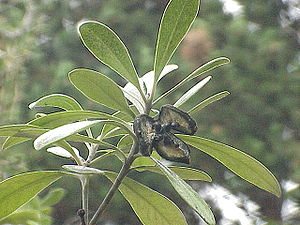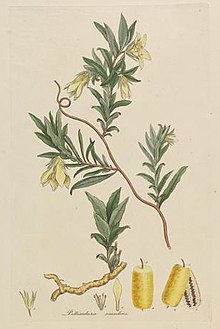Gluteal plants
| Gluteal plants | ||||||||||||
|---|---|---|---|---|---|---|---|---|---|---|---|---|

Pittosporum crassifolium , opened capsule fruit |
||||||||||||
| Systematics | ||||||||||||
|
||||||||||||
| Scientific name | ||||||||||||
| Pittosporaceae | ||||||||||||
| R.Br. |
The sticky seed family (Pittosporaceae) are a plant family within the order of the umbelliferae (Apiales). The six to nine genera with 200 to 250 species are common in the Paleotropic ; the center of biodiversity is Australia (42 species ).
Description and ecology
Appearance and leaves



There are always woody plants as shrubs , half-shrubs or small trees or vines grow. They are mostly evergreen. A special feature of the sticky seed family are the resin ducts in the bark , which are created when the cells move apart. Some types contain colored milky sap . The plant parts are bald or finely haired ( indument ). The plants are often armed with thorns. The secondary growth in thickness takes place through a conventional cambium ring.
The alternate and spiral , but often arranged so pushed to the younger branches that they quirlig appear leaves are divided into petiole and leaf blade. The simple, membranous to mostly leathery leaf blades have pinnate and network nerves. The leaf margin is usually whole, rarely lobed or toothed. The mostly paracytic, rarely cyclocytic stomata are often located on a spade side, usually on the underside of the leaf. In many species, the crushed leaves have a characteristic odor. There are no stipules .
Inflorescences and flowers
The flowers are sometimes also individually, usually in zymose , umbellate or umbelliferous , compound inflorescences . There are support and cover sheets .


In Pittosporum , Hymenosporum and Bursaria the flowers have a sweet scent. The flowers are mostly hermaphroditic, with a few species polygamomononce occurs. The often relatively large flowers are more or less radial symmetry and usually five-fold with a double flower envelope . The five sepals are mostly free or rarely only fused to their base. The five petals are often fused to form a corolla tube over part of their length, for example with Cheiranthera they are completely free. The colors of the petals range from white to yellow and red or blue. There is only the outer circle with five fertile stamens . In the species with corolla tubes, the relatively long stamens are partially fused. The anthers are usually free and usually open with a longitudinal slit, only with Cheiranthera with pores at their upper ends. Two or three, often up to five carpels are above a constant (syncarp), one to two, rarely multichamber ovary fused; sometimes the adhesion is not complete. Each ovary chamber contains one to many anatropic ovules . The relatively short style sometimes has five glands. The scar is usually rounded.
Fruits and seeds
They form fleshy to fibrous berries or dry, loculicidal capsule fruits . Often the capsule fruits jump open with flaps and present the colored, sticky pulp to encourage birds to eat the seeds they contain. The fruits rarely contain only one, usually a few, seeds per fruit compartment. Only with Hymenosporum are the seeds winged. The seed coat (testa) is thin, the oily endosperm is well developed and the embryo is relatively small but well developed.
Chemical characteristics
A wealth of ingredients from the Pittosporaceae family is known. Particularly noteworthy for the chemosystematics is the occurrence of polyynes (polyacetylenes), which underpin the relationship to the order of the Apiales, as well as the lack of petroselinic acid , which confirms the separation of the Pittosporaceae family from the Apiaceae and Araliaceae families .
Systematics and distribution



The Pittosporaceae family was described by Robert Brown in Matthew Flinders : A Voyage to Terra Australis , App. III, 1814, pp. 65-74. The type genus is Pittosporum Banks ex Gaertn. The German common name and the scientific genus name of the type genus Klebsamen ( Pittosporum ) refer to the sticky slime in which the seeds are embedded; Pittosporum is derived from the Greek words pítta for mucus and spérma for seeds.
Most species in the Pittosporaceae family are found in Australia . The others are found in tropical and subtropical Asia , Malesia , Africa (including the Canary Islands and Madagascar ) and New Zealand . This family is missing in the New World .
The sticky seed family (Pittosporaceae) contains six to nine genera with around 200 to 250 species. Except for the genus sticky seeds ( Pittosporum ), the genera often contain only a few species:
-
Bentleya E.M.Benn. : The only two species occur only in the Australian state of Western Australia :
- Bentleya diminuta Crisp & JMTaylor : It is native to Western Australia.
- Bentleya spinescens E.M.Benn. : This endangered species is native to Western Australia.
- Billardiera Sm. (Syn .: Labillardiera Schult. , Pronaya Hugel ex Endl. , Rhytidosporum F.Muell. , Sollya Lindl. ): The 25 or so species are allnativeto Australia .
- Bursaria Cav. : The six to seven species are common in Australia.
- Cheiranthera A. Cunn. ex Brongn. : The eight to ten species are common in Australia.
-
Hymenosporum R.Br. ex F.Muell. (Syn .: Pittosporum sect. Hymenosporum (R.Br. ex F.Muell. ) Baill.): With the only species:
- Hymenosporum flavum (Hook.) F. Muell. : It is native to New South Wales and Queensland as well as New Guinea .
- Marianthus Hugel ex Endl. (Syn .: Oncosporum Putt. , Rhytidosporum F. Muell. , Calopetalon Harv. ): The 14 bis species are common in Australia.
- Pittosporum ( Pittosporum Banks ex. Soland. , Syn .: Auranticarpa L.Cayzer, Crisp & I.Telford , Chelidospermum Zipp. Ex Blume , Citriobatus A.Cunn. Ex putt. , Glyaspermum inches. & Moritzi , Ixiosporum F.Muell. , Pseuditea Hassk. , Senacia Lam. , Senacia Comm. Ex DC. , Shoutensia Endl. ): The 140 to 150 species are distributed from Africa and Madagascar (nine species) across the Pacific islands to southern Asia and Australia (eleven species). There are 46 species in China, 33 of them only there.
use
Some Pittosporum species are used as ornamental plants .
Web links
- Profile of the Botanical Garden Tübingen. ( Memento from January 6, 2013 in the web archive archive.today )
swell
- The family of Pittosporaceae in APWebsite. (Sections Description and Systematics)
- The Pittosporaceae family at DELTA by L. Watson & MJ Dallwitz. (Section description)
- The Pittosporaceae family at Western Australian Flora . (Section description)
- Zhi-Yun Zhang & Nicholas J. Turland: Pittosporaceae. , P. 1 - online with the same text as the printed work , In: Wu Zhengyi, Peter H. Raven, Deyuan Hong (Ed.): Flora of China. Volume 9: Pittosporaceae through Connaraceae , Science Press and Missouri Botanical Garden Press, Beijing and St. Louis, 2003. ISBN 1-930723-14-8 (section description)
- Pittosporaceae at Tropicos.org. In: Flora of Pakistan . Missouri Botanical Garden, St. Louis, accessed May 11, 2014. (Description Section)
- Entry in the Australian Plant Name Index (APNI). (Section systematics)
- RO Makinso: The Pittosporaceae Family in the New South Wales Flora Online . (Sections Description and Systematics)
- ↑ a b c d e f g h i j k l m n o p q r s RO Makinso: The Pittosporaceae family in the New South Wales Flora Online .
- ↑ a b c d e f g h i j k l m Zhi-Yun Zhang & Nicholas J. Turland: Pittosporaceae. , P. 1 - online with the same text as the printed work , In: Wu Zhengyi, Peter H. Raven, Deyuan Hong (Ed.): Flora of China. Volume 9: Pittosporaceae through Connaraceae , Science Press and Missouri Botanical Garden Press, Beijing and St. Louis, 2003. ISBN 1-930723-14-8
- ↑ a b c d The Pittosporaceae family at DELTA by L. Watson & MJ Dallwitz.
- ↑ Thomas Stuhlfauth: Chemosystematic studies on the fatty acid composition of fruit and seed oils of the Pittosporaceae and some species of the Rutales and Araliales , diploma thesis at the University of Kaiserslautern 1984, pp. 22-51.
- ↑ Thomas Stuhlfauth, H. Fock, H. Huber , K. Klug: The distribution of fatty acids including petroselinic and tariric acids in the fruit and seed oils of the Pittosporaceae, Araliaceae, Umbelliferae, Simarubaceae and Rutaceae. In: Biochemical Systematics and Ecology. Volume 13, 1985, pp. 447-453. doi : 10.1016 / 0305-1978 (85) 90091-2
- ↑ Pittosporaceae at Tropicos.org. Missouri Botanical Garden, St. Louis, accessed on May 11, 2014.
- ↑ Pittosporaceae in the Germplasm Resources Information Network (GRIN), USDA , ARS , National Genetic Resources Program. National Germplasm Resources Laboratory, Beltsville, Maryland. Retrieved May 11, 2014.
- ↑ LW Cayzer, MD Crisp & IRH Telford: Revision of Pittosporum (Pittosporaceae) in Australia , In: Australian Systematic Botany , In: Volume 13, Issue 6, 2000, p. 846.
- ^ Genus Hymenosporum and species in the New South Wales Flora Online .
- ↑ LW Cayzer & MD Crisp: Reinstatement and revision of the genus Marianthus (Pittosporaceae) , In: Australian Systematic Botany , Volume 17, Issue 1, 2004, pp. 128-129.
- ↑ Pittosporaceae at Tropicos.org. In: Catalog of the Vascular Plants of Madagascar . Missouri Botanical Garden, St. Louis, accessed on May 11, 2014.
- ^ LW Cayzer, MD Crisp & IRH Telford: Revision of Pittosporum (Pittosporaceae) in Australia , In: Australian Systematic Botany , Volume 13, Issue 6, 2000, pp. 845-902.
